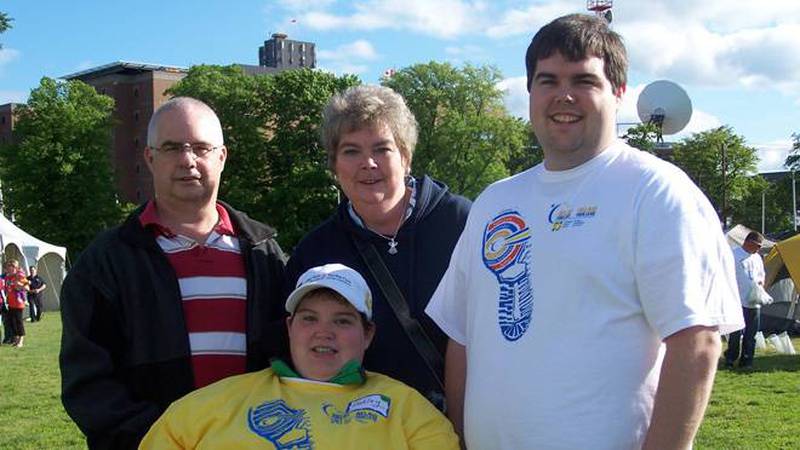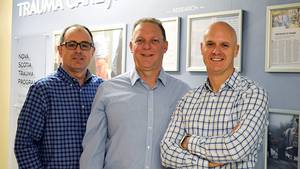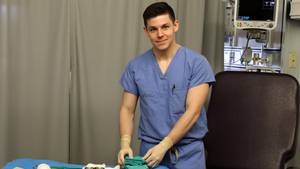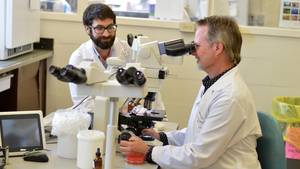When Wanda MacLean talks about the palliative care unit, she speaks of the team at the QEII Health Sciences Centre in Halifax as if they’re part of her family.
“They would move heaven and earth for us,” she says. “The palliative care unit was there for our family every step of the way. Their answer was always yes.”
Wanda’s daughter, Ashley, received in-hospital palliative care for more than 30 months in the Centennial Building at the QEII’s VG site before succumbing to alveolar soft part sarcoma (ASPS), a very rare type of soft tissue cancer. She was diagnosed with ASPS at age 20 and was the first in the Maritimes, second in Canada, to be afflicted with the disease, a slow-growing tumour that reaches out, grabbing onto soft tissue organs.
Ashley was also battling stage-four lung cancer.
Ashley died in January 2013 at the age of 23.
“She didn’t have her wings to grow yet,” says Wanda.
However, the doctors, nurses and all the staff on the QEII’s palliative care unit tried to make life for Ashley as normal as possible.
“They took wonderful care of her,” she says. “If we needed anything all we had to do was ask and we got it.”
Wanda recalls a time over the summer months when Ashley wished to enjoy a barbeque outside, and, without any hesitation and much enthusiasm, the staff made that happen.
“The hospital was Ashley’s home for two and a half years,” says Wanda. “Everyone knew her by name, even the cleaners. They let her decorate her room like it was her own bedroom at home and they catered to her just like she was a member of their own family. My husband, son and I appreciated that. We always trusted that she was in the best hands.”
A sense of calm
Ashley was originally admitted to the fifth floor where her initial treatment and care was provided. When her care became more complex, a decision was made to transfer her to the Palliative Care Unit. Wanda, who stayed overnight with Ashley occasionally, remembers being somewhat apprehensive when this decision was made.
“When they first told me she was going up to the seventh floor I felt a pit in my stomach,” says Wanda. “I was scared for her to go up there. But, I went up to take a look and it wasn’t what I had thought at all. I remember getting off the elevator and immediately feeling a sense of peace and calm. I didn’t see nurses running around or anything like that. I went over to the fish tank and saw the nice family room and started to feel very relaxed and I knew right then that everything was going to be alright there for Ashley.”
Ashley remained as Wanda’s reminder of their motto: One minute at a time. This line served as a mantra throughout Ashley’s battle, helping both mother and daughter remember to cherish the little things even during the most trying of times.
Quality of living
Palliative care is aimed at the relief of suffering, and improving the quality of life, for people who are living with or dying from advanced illness. The goal is to provide comfort and dignity for the person living with the illness, as well as the best quality of life for both the patient and their family. The service also helps patients and their families adjust to the idea of end of life and prepare for it.
Palliative care can be delivered at home, in-hospital or in a long-term care facility. While many people who receive palliative care have cancer, patients are also treated for other illnesses such as advanced heart disease, kidney disease, AIDS, ALS, advanced respiratory disease and multiple sclerosis.
Palliative care services include managing pain symptoms, assisting with decisions about treatments, and social, psychological, emotional and spiritual support. Support is also available for family caregivers and bereavement support can also be provided.
The QEII’s palliative care team includes doctors, nurses, physiotherapy, occupational therapy, music therapy and social work professionals.
To receive palliative care a patient must be referred by a family physician, medical specialist or healthcare professional. Palliative care is usually prescribed when the patient’s death is estimated to be imminent within 12 months.
Life goes on
Registered Nurse Monica McNamara provided care to Ashley. She says helping people deal with end-of-life issues is a key component of palliative care.
She points out that end-of-life counselling and support is a much-needed and helpful service because many people who have advanced illness find it difficult to think about dying, and many healthcare professionals, outside of palliative care, are not as prepared to have those conversations.
However, Monica says one of the misconceptions about palliative care is that it’s focused entirely on death.
“People tend to think that it’s all doom and gloom and that we talk in whispers here,” says Monica. “It’s not true. Palliative care is all about helping people live. It’s about helping them make the best of the time that they do have while they’re alive.”
And patients don’t always die while in hospital for palliative care, she adds. Often times people receive palliative care for treatment of nausea or other symptoms that have flared up, or because their families are unable to manage caring for them at home.
Registered Nurse Shelley McDonald, who also cared for Ashley, says patients are encouraged to be independent and lead as full of a life as they can while in treatment. Staff try to accommodate family gatherings and other social functions.
“Life goes on in here,” says Shelley. “We’ve had weddings on site, baptisms, spa treatments — you name it. It’s all about living.”
World-class researcher in end-of-life care
Working with the QEII’s Palliative Care Unit, the QEII Foundation has recently started fundraising for an Endowed Chair in end-of-life care.
The Endowed Chair will focus on researching innovative ways to achieve comfort and ensure respect for patients who are nearing death. Once the initiative is funded, the researcher will discover how to maximize the quality of life for patients in palliative care and their loved ones, making the patient’s dignity a top priority. The chair will be a world-leading researcher who is well known in the global medical community, globally.
Butterfly release
News of the QEII’s commitment to end-of-life care is welcomed by palliative care patients and their families, especially Wanda.
Wanda says one of her most precious memories of Ashley is the day of the butterfly release ceremony held for Ashley at the Public Gardens in August 2012, five months before she died. Wanda remembers how delighted Ashley was when one of the butterflies released landed on Ashley’s finger and stayed with her for several minutes.
Originally, the event had been planned for a later memorial for Ashley. But with their motto in mind, the butterfly release seemed most appropriate for Ashley to be part of.
“We wanted to do it while she was still alive,” she says. “That was Ashley’s wish.”








